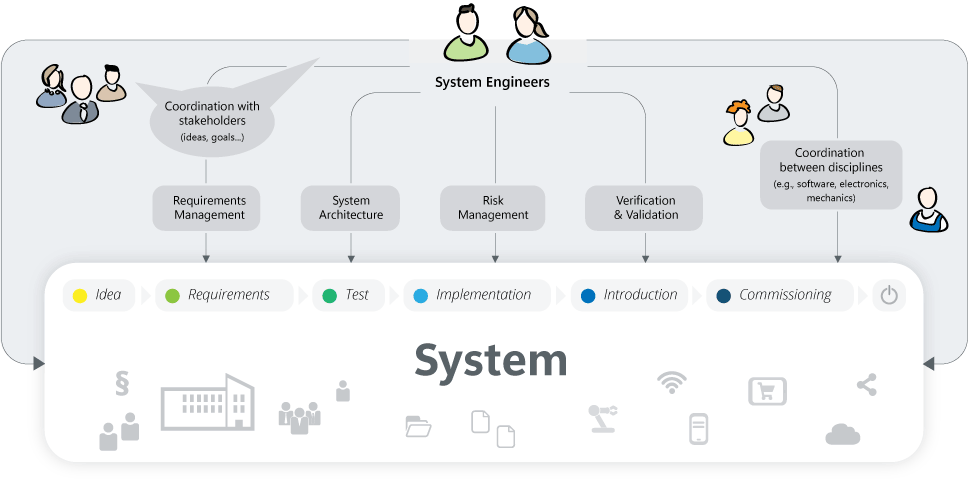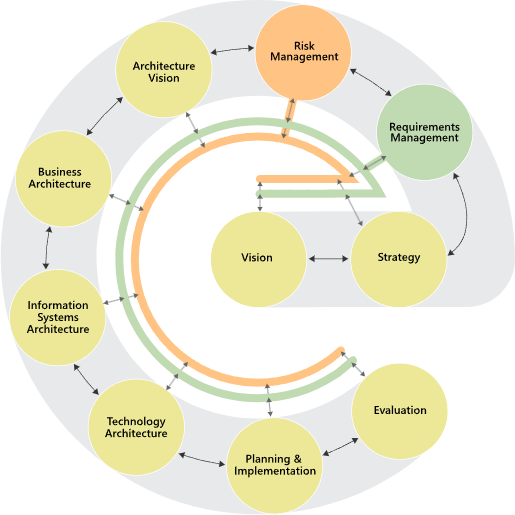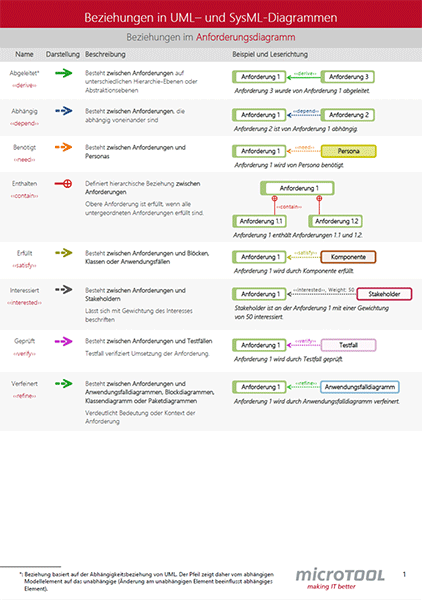What Is Systems Engineering?
How does it support the organization of complex systems?

System Engineers machen...
Das System Engineering durchläuft einen Lebenszyklus von der ersten Idee bis zur Einführung bzw. Stillegung eines Systems
Systems engineering is an interdisciplinary approach to developing complex technical systems. The overall goal is to manage all aspects of a system holistically, including requirements, design, development, operation, and decommissioning.
What Is a System?
In systems engineering, a “system” is a combination of elements that work together to fulfill a specific function. These elements can be a technical product, a software solution, a machine, or even a cross-organizational process.
The focus is on the system as a whole, considering hardware, software, mechanics, electronics, people, and organization. Systems engineering establishes a shared understanding among all involved parties. It aims to lay the foundation for transparent decisions, efficient development, and high quality.
“Systems engineering is a transdisciplinary and integrative approach that uses system principles and concepts, as well as scientific, technological, and management methods, to enable the successful realization, utilization, and decommissioning of technical systems.”
German Society for Systems Engineering (GfSE)
How Did Systems Engineering Originate?
Systems engineering originated in the field of aerospace. Today, this approach is used in many industries, including automotive, medical technology, plant engineering, defense, and IT.
It emerged in the mid-20th century, primarily in the context of aerospace in the United States. As demands on technical systems increased, including rocket programs, satellites, and large-scale computing systems, it became clear that traditional engineering disciplines alone could not handle the growing complexity.
During the 1950s and 1960s, companies like Bell Labs and NASA developed systematic methods to make complex technical projects more manageable and comprehensible.
Later, other industries adopted this approach. Systems engineering has also become established in Germany. The Gesellschaft für Systems Engineering e.V. (GfSE) plays a central role in this development. As the German branch of the international organization INCOSE (International Council on Systems Engineering), it is committed to promoting and disseminating systems engineering in German-speaking countries.
What Are the Responsibilities of a Systems Engineer?
Requirements Management
Collect, analyze, and structure requirements from the perspective of all stakeholders.
Systems Architecture
Design and modeling of the system structure including all subsystems, interfaces, and interactions.
Coordination and Integration
Ensure coordination between disciplines (e.g., mechanics, electronics, and software) to ensure smooth integration.
Risk Management
Identify and assess technical risks, and derive appropriate countermeasures.
Verification and Validation
Checking whether the developed system meets the requirements (verification) and whether it is suitable for the intended purpose (validation).
Life Cycle Orientation
Planning and support for the system throughout its entire life cycle – from the initial idea to decommissioning.
In short, systems engineers are responsible for maintaining the technical, organizational, and communicative aspects of a system.
What Is the Difference between “Systems Engineering” and “System Engineering”?
The terms “system engineering” and “systems engineering” are often used interchangeably, particularly in German-speaking countries. Strictly speaking, however, there is a difference:
- “System engineering” is an imprecise or abbreviated term that occasionally appears in German-language sources, but it is not used normatively.
- “Systems engineering” is the established technical term in an international context, especially in English-speaking countries, and refers to a holistic approach to developing complex systems.
The correct and common form, used in standards such as ISO/IEC/IEEE 15288 Systems and Software Engineering — System Life Cycle Processes, is “systems engineering.”
Standards and Methods in Systems Engineering
Systems engineering is supported by the following international standards:
- The INCOSE Handbook provides practical methods and guidelines
- SysML (Systems Modeling Language) is a modeling language specifically for system architectures
Methods such as requirements management, traceability, use cases, model-based systems engineering (MBSE), TOGAF (The Open Group Architecture Framework), and enterprise architecture management (EAM) are also used.
Integration of MBSE in Systems Engineering
MBSE (Model-Based Systems Engineering) is the systematic use of models to support requirements, design, analysis, verification, and validation tasks during the design phase and throughout the development process. Using models makes relationships and interfaces more visible and easier to verify.
One frequently used modeling language in MBSE is Systems Modeling Language (SysML). SysML helps map technical systems in a structured way, creating the basis for a consistent, model-based approach.
What is Systems Modeling Language (SysML)?
SysML is a standardized modeling language designed specifically for describing technical systems. Developed to address the unique needs of systems engineering, it is based on the well-known Unified Modeling Language (UML). SysML 2.0, released as a beta version in 2024, significantly enhances the language. It is now based on the Kernel Modeling Language (KerML), which provides greater clarity and consistency.
SysML can be used to model complex systems in a structured way and accurately visualize relationships.
Well-known diagram types in SysML include:
- Requirements diagrams: These diagrams visualize requirements and their relationships.
- Block diagrams: These show the structure of a system and its subsystems.
- Activity diagrams: They describe procedures and processes.
TOGAF (The Open Group Architecture Framework)
TOGAF is an internationally recognized standard for developing and managing enterprise architectures. It provides a structured framework with clearly defined phases, methods, and tools for creating complex IT and business architectures systematically.
At the heart of TOGAF is the Architecture Development Method (ADM), an iterative process that guides users from initial ideas to the implementation of an architecture. TOGAF helps organizations link IT structures to strategic business goals, identify technical dependencies, and develop sustainable architectures.
When used with systems engineering, TOGAF establishes the methodological foundation for architectural work in large-scale IT and system projects. Learn more in our Knowledge Base article on TOGAF.
Enterprise Architecture Management (EAM)
EAM focuses on the holistic planning, control, and development of a company’s IT architecture. Its goal is to align IT systems, applications, data flows, and technologies with strategic objectives.
In large organizations, EAM reduces complexity, avoids redundancies, and clearly defines interfaces. In conjunction with systems engineering, individual systems are not viewed in isolation but rather in the context of the overall corporate structure and business processes.
See How Systems Engineering Works in the Tool.
Learn more about systems engineering, from requirements management to system architecture, with objectiF RPM »
Systems Engineering in Practise by microTOOL
Those who want to manage their projects successfully based on systems engineering will benefit from tried-and-true templates and structures. The mEAF template in objectiF RPM offers a reliable foundation.
The microTOOL Enterprise Architecture Framework (mEAF) was specifically developed for architecture and system projects. Unlike traditional frameworks, mEAF integrates requirements and risk management as central components that run parallel to the architecture phases.
Learn more about the microTOOL Enterprise Architecture Framework here »


